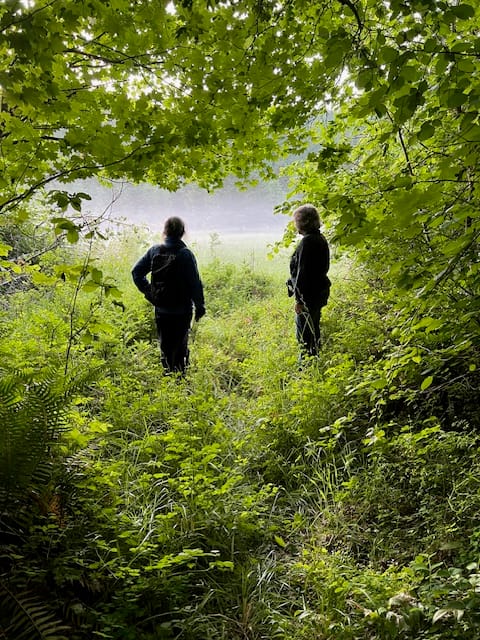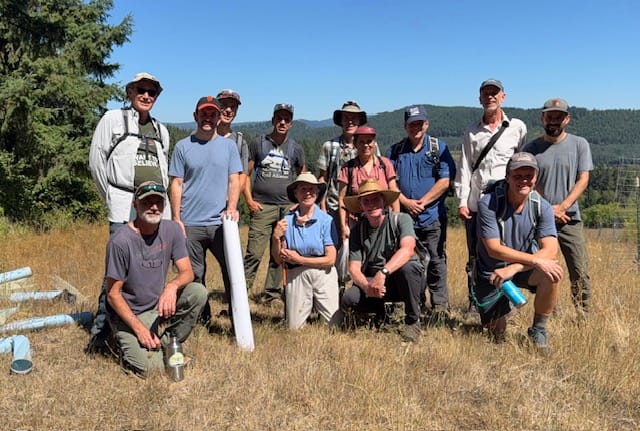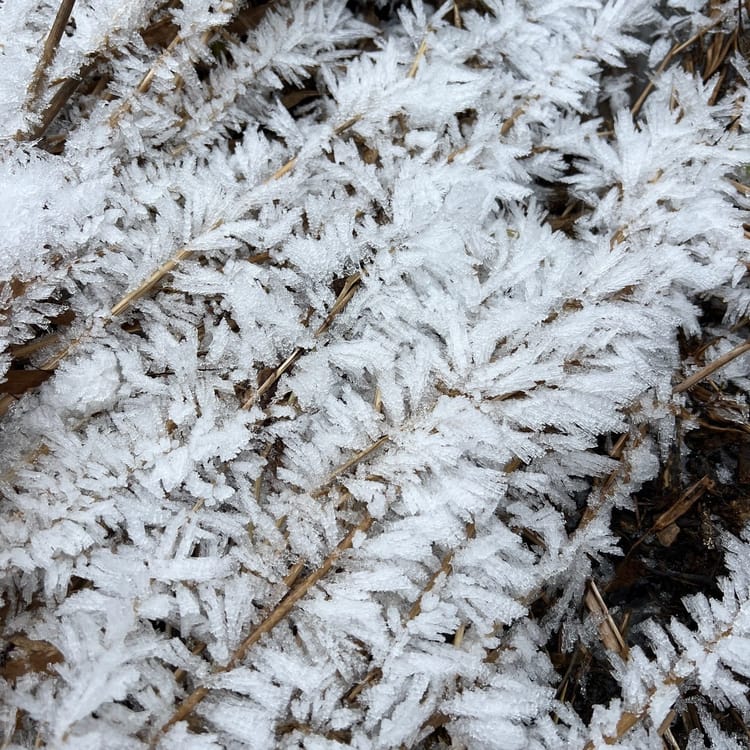Quarterly Update - 2025 Q3:

Adapting to the Unexpected -
When this project was imagined and committed to back in 2019, conditions were significantly different than they are six years later. At that time, it felt to me like many conditions in the wider world were relatively stable and somewhat predictable. In contrast, over the past five years we’d been surprised by rapid, significant and unexpected changes within one of our three forests. These changes included major tree die off in several parts of the forests and rising stresses. While there were rapid changes, well outside of our range of experience, to track, study and try to respond to within our forests, the wider world, though always in flux, felt relatively dependable. The biggest challenge as I sit down to share this update is that the rates of change in these two worlds have flipped. The news from the forests feels remarkably and refreshingly uneventful while the rapidity and significance in change in our wider world is far beyond anything in my lifetime. These changes present me, the witness and chronicler, with a dilemma – how will I best find a balance between staying true to anchoring this project in the daily realities of our forests while also including hopefully useful observations on the overwhelming changes and uncertainties in the United States. Because the scope of the second task is beyond my capacities, I am working to make that challenge more realistically manageable by concentrating on those changes in the wider world which have direct bearing on the forests. Fortunately, a life of caring for forests encourages me to be creatively adaptable in the face of changing circumstances.
The Forests in Summer –
Summer life in the forest is normally driven by several opposing trends. The first is the progressive tapering off of precipitation as the summer advances. With each passing day of one clear, warm day following the next, it is not long before I’m asking myself “do you think it will ever rain again?”. The counter trending line is the rising numbers of hot days as we move from June into July and on into the long dog days of August. Where the sun’s warmth was once so welcome after a long winter, too soon, it becomes a limiting factor that I dread and work strategically to adapt to. In answer to my question of “are these summers getting hotter, or is it just me?”, a look at the data shows that average temperatures for the three summer months in our area rose 3.7 deg, over the past fifty years and the average of overnight lows rose 5.4 deg. over the past eighty years. Over the summer, as temperatures rise and rainfall drops, this feeds the annual pattern of stream flows tapering down, the forests drying out, the songs of birds becoming quieter and the once vibrant, and differentiated greens of spring shifting to a duller sameness.
But then, much welcomed relief comes in the form of clouds rolling in off of the cool ocean to the west. Eventually the clouds drop their moisture across the thirsty, dry, sleeping forests and they, once again, come back to life. As summer rolls into fall, temperatures drop, the birds reclaim their voices, streams grow from trickles, wildfire risks and restrictions decline and, revived once more, us forest keepers get back to work. Every year there is a long list of projects that we hope to get to get to in that window between the end of summer and the onset of winter rains. This past summer felt welcomely uneventful – no spiking temperatures, no nearby wildfires, predictable and welcome growth all across the forests.
Crossing the Line – Changes in the Neighbors -
On an already hot August morning, a group of us bushwacked from an inspiring spring on federal land back across onto our Hyla Woods forest. While weaving our way between the ferns, trees, rocks and vines, Andrew asked “so Peter, were does the property line run through here?”. No sooner had I sized up the landscape and replied “right about here” than Andrew pointed to the ground beneath my feet and asked “could that be what’s left of the fence line?”.
When I looked down, there was a subtle but significant historical clue. At my feet was an articact that I had never noticed, in spite of the many dozens of times I had walked that route. Rusting strands of old fence wire, sat mostly hidden beneath the jumble of forest vegetation. A straight line, amid nothing straight, delineating the line between public from private.

Since stepping over those overlooked remains of the old fence on that August morning, the symbolism of crossing that line sticks with me. After many decades of leaning on fact supported assumptions about our relationships with our neighbors, the Bureau of Land Management as an arm of our federal government, what has changed and what can and can’t we count on? As we cross from our Hyla Woods forest to our public forest, the differences on the land are imperceptible, yet when I consider recent changes in the federal government, so much has rapidly changed. We’ve crossed a line and are challenged to acknowledge, understand and respond to those changes.
Here is a sampling of what seem to be the most significant changes:
- Though the stewardship capacity of BLM staff in western Oregon has always been slim, in the past we had reason to count on them pay attention to and care for the forest adjoining ours in a minimally, but adequately, responsible way. Due to downsizing of the staff and departure of many with essential knowledge and commitment, this is no longer true. From phone conversations with BLM staff, I learned that they are not allowed to share information on changes in staffing levels.
- Where, in the past we could count on the actions of federal staff being guided by and grounded in respect for the rule of law, recent events show that we can no longer count on that.
- The trust and respect that BLM foresters had earned over decades through their commitment to grounding their policies and practices in science, including the urgent need to address the twin crises of climate and biodiversity loss has been decimated by the new policies of the federal government.
- Where not long ago we could count the implementation of on long followed policies that required our BLM neighbors to communicate with us when they planned to take action on the land and provided avenues for us to be informed and engaged, my recent conversations with local BLM staff highlight the new reality that the land could be aggressively logged and/or sold without our being notified or involved.
- The confidence that we once had that recourse to litigation to force our government to obey land-based laws, such as the Endangered Species Act and Clean Water Act is no longer justified given the politicization of our highest courts.
- Over many decades we have developed and benefitted from many valuable, land stewardship partnerships with terrific staff from federal agencies – including the US Fish and Wildlife Service, US Forest Service, National Marine Fisheries Service and the BLM. This led to positive land restoration outcomes both on our forests and across the region. Due to recent changes essentially all of these partnerships have been discontinued and participating staff are largely gone, through either termination of retirements. Research equipment set up in the forest by federal partners now sits untended with no certainty if and when the research will resume.
- Resilient forests in our region depend on the hard and careful work done by crews of our Latino neighbors. The acceleration of illegal federal action targeting these friends, neighbors and partners cause us to both worry about their well being and to wonder whether our partnerships in forest stewardships will continue. Meanwhile, over the hill in Portland, federal officers continue to harass citizens and local police in hopes of provoking violence that could be used as false justification for additional, unwarranted federal activity.
On June 28th, 2021 when the temperature in the forest rose to more than ten degrees above anything ever before experienced in the forest, it became clear that we had crossed a line into unfamiliar and unprecedented territory. Something we’d counted on, how hot it could get, could no longer be counted on. Similarly, looking down at my well-worn boots swinging across the rusted wire marking the edge of federal land, I acknowledge and wrestle with the reality that another line has been crossed. The relationships that we long counted on with our neighbors have been fundamentally and dangerously changed. In the same way that our stewardship has been changed to work with hotter summers, we must now work out what’s required for us to adapt to the changes in our neighbors and much weakened partners.
What’s There to Love?
Saving the best – and more upbeat – for last, I will share a pair of images from this past summer that remind me of how much is there to love and appreciate in the forests. The first is one that we can and do count on and one of my all-time favorites. As shared above, there comes a time in each long, hot and dry summer where the forest becomes stressfully crispy dry, fire risk is high and it is best to just hunker down to wait for this challenging season to pass. All of that changed when the first soaking rain returns life to the forest. Clouds roll in, the sky darkens, fat and heavy drops noisily splatter on the thirsty leaves. Before long, rain is falling all across the forest, turning the once dusty roads into pathways for rushing run off. And the best part of this? The best part of this – is the wonderful smells released by the cool rain reinvigorating the parched forest. For me, my appreciation for this much welcomed moment in the year is equal parts sheer pleasure in the smells, sounds and feel as well as the way that it reminds us that rains eventually return, signaling the rolling from summer into fall. One indicator that there is something basically human about this moment is that there is a word for it – petrichor.
The second experience began at 8 AM on August 11th when thirteen of us gathered on the edge of Mt. Richmond Forest to experiment with a first ever adventure. With the thermometer already reading over 80* and forecasted to hit 102*, we all rightly questioned our judgement as we ran around a circle of quick introductions. We were all keen to beat the day’s heat. Forest stewards, agency staff, non profit leaders, forest advocates and restorationists, conservation scientists, we joined in rising to the challenge of walking a four mile loop through the forest with the goal of visiting and monitoring twelve of the forests’ precious springs. Introductions and orientation complete, we set off in the morning’s relative cool in search of what the springs might teach us in this driest, hottest and least inspiring season of the year. For the next three hours, we made our way from spring to spring. Along the way we explored, monitored the springs, creeks and forest, bore witness and appreciated the role of water in the life of the forest, learned from and visited with one another, shared questions and strengthened the relationships, values and dreams that bind us together. As the clock struck noon and the thermometer passed from two digits to three, we took stock of the final spring and slogged up the final hill to our starting point. In spite of the heat, group members lingered at their cars, reluctant to cut off interesting conversations.
While so many of my answers to “what’s there it love?” in these forests focus on the more-than-human, it is also easy to find many that don’t. On this day when game friends took the risk to come together for an unproven, “why not?” adventure, I was reminded of the gift that is the human community that we are members of. Like the forest’s ecological community, it is diverse, interconnected and interdependent, mutually supportive and unique to this place. How lucky we are to know, learn from and be supported, challenged and inspired by one another – particularly as we find our way through these challenging and novel times. The forest’s richness comes in many forms. Solidary to counter the forces that work to divide us.

Speaking of “what’s there to love?”, I could share news of the bear that recently left smudgy nose prints on the windows of the hilltop cabin, chomped the corner of a cooler and shredded a window scene, but that can wait until next time.....
Thank you for joining me on this adventure!
Atmospheric Co2 Measurements from Mauna Loa, Hawaii (link):
Nov. 2025 – 426.56 ppm
Nov. 2024 – 423.64 ppm
Nov. 2023 – 420.37 ppm

